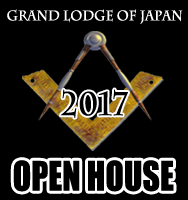FREEMASONRY / フリーメイソン
What is Freemasonry?
A peculiar system of morality, veiled in allegory and illustrated by symbols.
Most Masons would agree with this elegantly concise definition of Freemasonry. To a non-Mason, however, it raises more questions than it answers.
A more concrete definition might be:
Freemasonry is a fraternal organization that seeks the self-improvement of its members and, through them, the improvement of society. This self-improvement is carried out by borrowing the narratives and symbols of medieval stonemasons and using them to teach fundamental lessons of truth, morality, brotherly love, and charity.
In their meetings, Masons imitate the gatherings of ancient stonemasons. The cutting and polishing of stones is used, for example, to illustrate the shaping of personality, the construction of King Solomon's Temple to symbolize the building of character, and tools such as squares and compasses to represent virtues such as honesty, prudence, and moderation.
What's the difference between Masonry and Freemasonry?
None whatsoever. The two terms are interchangeable. To avoid ambiguity, however, Masonry is usually written with an uppercase M to distinguish it from the stonecutter's craft of masonry. Freemasonry is perhaps the more accurate term, but Masonry is shorter and more convenient. Other words commonly used to refer to Freemasonry are The Craft or The Fraternity.
What's a Grand Lodge?
An organization that supervises, regulates, and coordinates the activities of Masonic lodges within its area of jurisdiction.
This area of jurisdiction is usually defined geographically.
However, some areas encompass two, three or more Grand Lodges with differing historical and ideological backgrounds. Relations between Grand Lodges resemble those between sovereign nations. Some recognize one another and enjoy cordial relations, others do not.
What's the origin of Freemasonry?
Masonic scholars have been trying to answer this question for almost three hundred years. National pride and a lack of documentation have spawned many theories, the most popular being the least tenable. Many Masons are convinced that Freemasonry began with the formation of the Grand Lodge of England in 1717.
In that year four of the many lodges in the London area met at a tavern to discuss the possibility of cooperating in annual events. For several years little came of this initiative until, in 1723, a concerted effort was launched to create a supervising body and persuade hitherto independent lodges to recognize its authority. Many lodges preferred to remain independent and Freemasonry got off to an unsteady start. Lodges in Ireland and Scotland were equally reluctant to abdicate their authority to a new organisation. The Grand Lodge of Ireland was founded in 1725 and the Grand Lodge of Scotland in 1736. The oldest Grand Lodge in the United States is that of Massachusetts, which traces its origins to 1733.
The only region for which we have reliable documentation is Scotland. This documentation dates back to the late 16th century and shows the transition from lodges of operative stonemasons to lodges with a significant membership of so-called ‘speculative’ non-masons. As to why non-masons should have shown an interest in what was little more than a guild of stonemasons, the answer lies in the cultural history of Scotland and the blossoming of the Scottish Renaissance, a subject far too broad and deep for this short FAQ.
Is Freemasonry a religion?
Apart from a requirement for a belief in a Supreme Being (a requirement lifted by a small minority of Grand Lodges), Freemasonry respects the religious affiliations of its members and makes no attempt to influence them.
That being said, Masonry draws much of its allegory from the Judeo-Christian Bible, a natural consequence of its birth in the cultural environment of pre-17th century Europe. Despite this background, for three centuries followers of all the world’s religions have joined the Fraternity and experienced no conflict with their personal beliefs.
Is Freemasonry a secret society?
The usual answer to this question is that Freemasonry is not a secret society but a society with secrets.
These secrets relate to the modes of recognition used by ancient stonemasons to establish their credentials as trained craftsmen. All of these modes of recognition were made public in the earliest Masonic exposés and, after three hundred years, can hardly be called secret.
Is there a secret conspiracy at the core of Freemasonry?
This misunderstanding probably stems from the 33-degree system of the Ancient and Accepted Scottish Rite, a series of degrees created in France not Scotland, and based on allegories of chivalry rather than masonry.
Within this system, the highest degree is awarded as an honor to a limited number of outstanding members. Other conspiracy theories are based on proven fabrications such as the notorious Protocols of the Elders of Zion, or the criminal activities of rogue lodges such as Propaganda Due (P2) in Italy. That millions of Freemasons have found no trace of secret cabals within their organization should help to put things in perspective.

